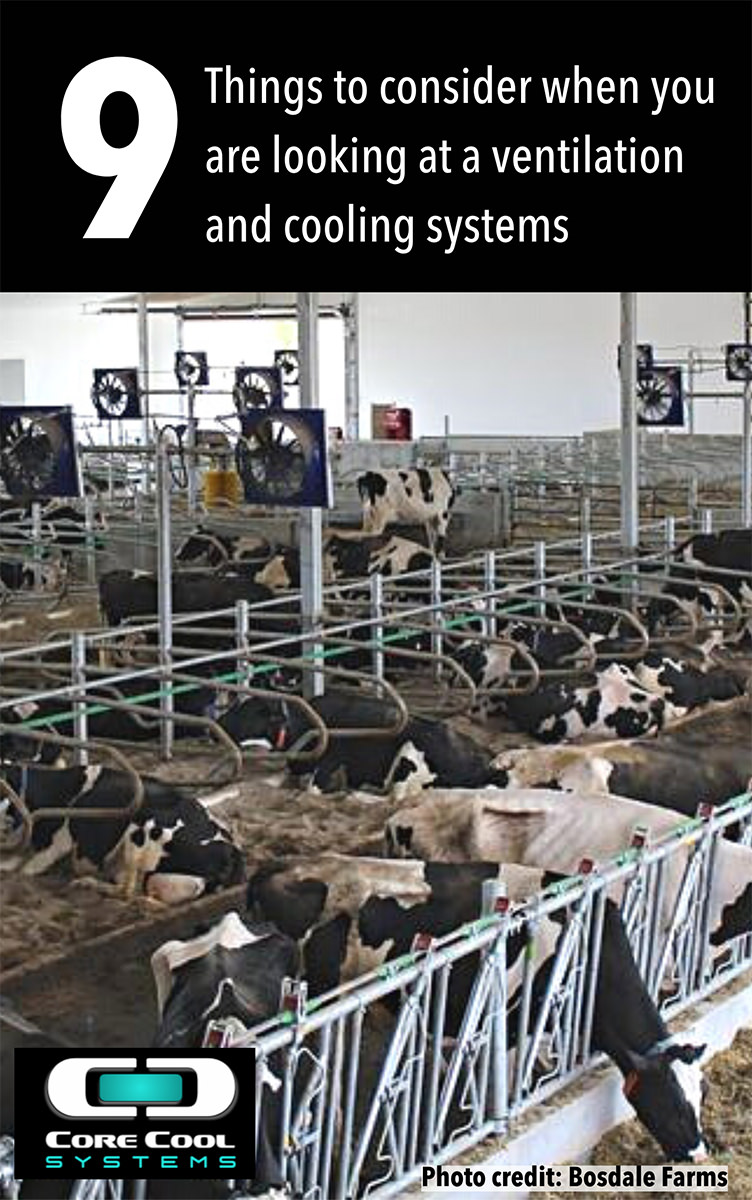Title search: ✖
|
Show All (51)
Cooling Cows (28) Cow Comfort (6) Dry Cow Cooling (1) Fall Lameness (2) FAQ's Answered (7) Metabolic Issues (2) Reproduction (2) Why Focus on Core Body Temperature (4)
FAQ - Why should I cool my dry cows? What impact does heat stress have on the cow, her next lactation, the calf in utero
Why is it important to keep cows' core body temperature cool, and how does Core Cool Systems achieve this?
Maximizing Dairy Herd Reproductive Health: Understanding the Impact of Heat Stress and Investing in Cooling Solution.
Are your summer electricity bills causing you to shudder? Maybe your barn fans are one of the biggest culprits.
Why is it important to clean your fans before summer? Are dirty fans costing you time, money and energy?
|
Are your summer electricity bills causing you to shudder? Maybe your barn fans are one of the biggest culprits.I have a few questions.
Did you know you can figure out power consumption of your current system or future systems you are looking to purchase? You can. In just a few steps you can know how much electricity your systems will use running at 100% for 24 hours. (or however many hours per day you want to calculate) It all starts with knowing how many watts your fans are using. This information should be on the fan motor label or in the owner’s manual, you may need to Google the make and model to find the fan's specification.
All fan specifications are slightly different. In this example the watts are not included. People in the fan industry love confusing their customers! I don’t know why, but it’s the truth. Because of this we have to do a quick calculation to find out the watts(W). You need to know the amps and volts and figure out the watts. (Underlined in yellow)
Part 1 – Calculating Watts - If you know the watts – Skip to part 2 Let’s use the information from the specifications above. 5.3 amps (max amp draw) and 230 volts Volts x Amps = Watts 230 V x 5.3 Amps = 1,219 Watts This website has a calculator that will do the math for you.https://circuitdigest.com/calculators/amps-to-watts-calculator
Part 2 - Kilowatt Once you know the watts, you can figure out the kilowatts. “A kW or kilowatt is a unit of measurement for the rate of power an electrical device or load uses. The higher the kW of a device, the more electrical power is needed to operate it. “ https://www.power-sonic.com/blog/kw-vs-kwh-explained/ A kilowatt is 1000 watts (W). 1000 W = 1 kW. Example: 1,219 Watts divided by 1000 = 1.219kW
Part 3 – Kilowatt hour (kWh) Why do we need to know the Kilowatt Hours? Because we pay for electricity in kWh. A kWh or kilowatt-hour measures the energy usage of an electrical device or load. The higher the rate of power (kW) of an electrical device and the longer it is used (hours), the more electricity it consumes (kWh). Power Usage Calculations Example: 1.219kw x 24 hours = 29.256 kWh The fan in our example using 5.3 amps of power is consuming 29.256 kWh in 24 hours If your barn is 240 ft long and you have 4 rows of cows and 2 feed bunks 240 ft x 4 rows of beds = 960ft 240 ft x 2 feed bunks = 480ft You have a total of 1,440 ft to cool. Many producers use bunk line soakers and fans to cool cows at the feed bunk and fans over the beds. The traditional rule of thumb for distance between fans was, 1 ft for every inch of fan blade. According to this calculation a 52” panel fan would be spaced at 50ft. 240ft at 50ft spacings is 5 fans/row 1,440ft at 50ft or 6 rows at 5 fans/row equals a total of 30, 52” panel fans. If we take our example fan that is using 5.3 amps consuming 29.256 kWh in 24 hours and multiply that by 30 fans. 29.256 kWh x 30 fans = 877.68 kWh/day. What about in a month? 877.68 kWh/day x 30 days = 26,330.4 kWh for the month That’s running at 100% for 24 hours a day for 30 days. How many months a year are your fans running at 100% for 24 hours? What could that power usage look like in terms of dollars on your power bill? Let’s say you are paying 0.07cents per kWh 26,330.4 kWh x 0.07cents = $1,843.00 for electricity for 30 fans for 1 month.
However, in a document put out by The Dairy Initiative, University of Madison Wisconsin, it is stated, “Previous recommendations for fan placement in barns stated that fans should be spaced at 10 fan diameters apart and angled toward the cows. This recommendation does not meet the goal of providing sufficient air speed to as many cows as possible in the resting area and should no longer be used.”
If we were to double the number of fans to meet the Dairyland Initiative recommendations the number of fans would increase to 60. Doubling the cost of electricity to $3,686.00 per month for every month the fans are operating at 100% power for 24 hours a day.
How can Core Cool Systems save you power? The powerful Core Cool unit that pushes air farther and faster than any other fan on the market. It’s performance to size ratio is in a league of its own. Here are the 3 most popular Core Cool models.
Let’s take that same 240 ft barn. Using the single-phase units, spaced at 60ft. At this distance the airspeed is 5mph/7kph. 240ft per row at 60ft spacings = 4 – 25” 0.9kW Single phase Core Cool Units per row 6 rows x 4 units/row = 24 Core Cool units. 0.9 kw x 24 hours = 21.6 kWh per Core Cool Unit. 24 units x 21.6 kWh/24 hours = 518.4 kWh/day 518.4 kWh/day x 30 days per month = 15,552 kWh/month 15, 552 kWh/month x 0.07 cents per kWh = $1,088.64 per month in electricity. Let’s recap those electricity usage comparisons.
Conclusion: Core Cool Systems will save you money on electricity bills, plus so much more.
If you would like help running these calculations for your farm, please contact nancy@corecoolsystems.com or call Nancy at 1-844-438-5845
P.S. To keep the comparison equal we use all fans running at 100% power. The Core Cool Systems has a value-added benefit of an EC motor. Electronically Commutated (EC) motor; variable speed without needing an external variable frequency drive. In variable speed the Core Cool unit is even more energy efficient. The 52” Panel fan are single speed, in order to be variable speed a VFD (variable frequency drive) The 52” Panel fan will still consume 5.3 amps of power even though it’s in variable speed. P.P.S. Be sure to check out water usage comparison between a traditional bunk line soaker system and a Core Cool System. Resources: https://circuitdigest.com/calculators/amps-to-watts-calculator https://www.power-sonic.com/blog/kw-vs-kwh-explained/ https://www.rapidtables.com/calc/electric/energy-consumption-calculator.html
Share: https://www.corecoolsystems.com/blog/Blog34/Are-your-summer-electricity-bills-causing-you-to-shudder-Maybe-your-barn-fans-are-one-of-the-biggest-culprits Share Category "Cooling Cows": |

